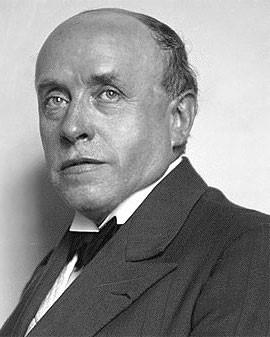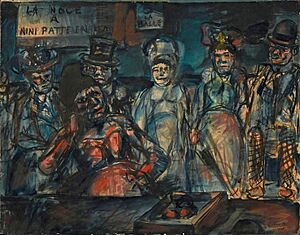Georges Rouault facts for kids
Georges Henri Rouault (born May 27, 1871, died February 13, 1958) was a famous French artist. He was a painter, a draughtsman (someone who draws), and a printmaker. His art style is often linked to two important art movements: Fauvism and Expressionism.
Contents
Early Life and Learning About Art
Rouault was born in Paris, France, into a family that didn't have much money. He was even born in a cellar because his family's home was destroyed. This happened during a difficult time in Paris in 1871.
His mother really supported his interest in the arts. When he was 14, in 1885, Rouault started learning to paint and restore glass. This training lasted until 1890. Many people think this early work with glass is why his later paintings have strong black outlines and bright, glowing colors. These colors look a lot like stained glass windows.
While learning about glass, he also took evening art classes. In 1891, he got into the École des Beaux-Arts. This was a very important art school in France. There, he studied with a teacher named Gustave Moreau. Rouault became Moreau's favorite student. Moreau's influence can be seen in Rouault's early use of color. When Moreau died in 1898, Rouault became the curator of the Moreau Museum in Paris.
Starting His Art Career
In 1891, Rouault painted a work called The Way to Calvary. He won an art prize, the Prix Chenavard, in 1894. From 1895 onwards, his art was shown in big public exhibitions. One important show was the Salon d'Automne, which he even helped to start. He showed paintings of religious scenes, landscapes, and still lifes there.
Rouault became friends with other famous artists like Henri Matisse and Albert Marquet. These friendships led him to the Fauvism art movement. Matisse was seen as the leader of this group. In 1905, Rouault showed his paintings with the other Fauvists at the Salon d'Automne. While Matisse was known for being thoughtful and planned, Rouault's style was more natural and emotional.
His use of strong contrasts and deep feelings in his art was influenced by the artist Vincent van Gogh. Rouault's way of showing exaggerated, sometimes strange, characters also inspired Expressionist painters.
Expressionist Art and Religious Themes
Rouault's paintings often showed people in a way that made you think about society. He became interested in spiritual ideas and the deep thoughts of the philosopher Jacques Maritain. Maritain remained a close friend throughout Rouault's life. After this, Rouault focused his art on religious subjects. He was always very interested in human nature. Rouault once said that "A tree against the sky possesses the same interest, the same character, the same expression as the figure of a human."
In 1910, Rouault's art was shown for the first time at the Druet Gallery. Artists from Germany who later started the Expressionist movement studied his works.
From 1917, Rouault spent all his time painting. His strong Christian faith guided his work. He is seen as one of the most dedicated Christian artists of the 20th century. A main theme was the suffering of Christ. The face of Jesus and the cries of the women at the cross showed the pain of the world. For Rouault, belief in resurrection brought relief from this pain.
In 1929, Rouault designed the sets and costumes for a ballet called The Prodigal Son. The music was by Sergei Prokofiev and the dance was by George Balanchine.
By 1930, his art was being shown in other countries. He had exhibitions in London, New York, and Chicago. In 1937, Rouault painted The Old King, which many consider his best Expressionist work.
In 1948, he showed his series of prints called Miserere.
Later Life and Legacy
Towards the end of his life, Rouault did something surprising. He burned about 300 of his paintings. These paintings would be worth a lot of money today. He said he did this simply because he felt he wouldn't live long enough to finish them.
Georges Rouault died in Paris on February 13, 1958, when he was 86 years old.
Images for kids
See also
 In Spanish: Georges Rouault para niños
In Spanish: Georges Rouault para niños




